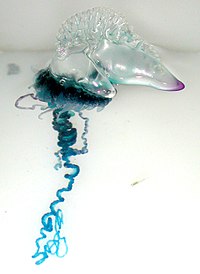
Photo from wikipedia
ETHNOPHARMACOLOGICAL RELEVANCE Wuwei Shexiang Pills (WWSX), a classic Tibetan medicine, consists of Chebulae Fructus (removed pit), Aucklandiae Radix, Moschus, Aconiti Fiavi Radix, and Acori Calami Rhizoma. It is used clinically… Click to show full abstract
ETHNOPHARMACOLOGICAL RELEVANCE Wuwei Shexiang Pills (WWSX), a classic Tibetan medicine, consists of Chebulae Fructus (removed pit), Aucklandiae Radix, Moschus, Aconiti Fiavi Radix, and Acori Calami Rhizoma. It is used clinically in China to treat joint pain, swelling and other symptoms, and has the function of dispelling wind and relieving pain. However, to date, the mechanism of how it works against gout is still unclear. AIMS OF THE STUDY Using network pharmacology, molecular docking and pharmacological verification to explore the potential anti-gout properties of WWSX. MATERIALS AND METHODS With the use of UPLC-Q/TOF-MS, the main components of WWSX were obtained and screened for potential anti-inflammatory components by network pharmacology and molecular docking. The anti-inflammatory activity of the components screened from WWSX was also tested by in vitro assays. The anti-gout mechanism of WWSX was predicted by network pharmacology, and the pharmacological validation experiments using gouty arthritis model and mouse air pouch model were used to explore the multifaceted mechanism of WWSX to modify gout. RESULT Thirty-eight active ingredients were obtained from the UPLC-Q/TOF-MS detection. The network pharmacology and molecular docking analysis showed that 104 co-targets were participated in the treatment of gout, and the main signaling pathways involved were NOD-like receptor pathway, NF-κB pathway and MAPK pathway. Pharmacological evaluation showed that WWSX could significantly improve gout in gouty arthritis models and mouse air pouch models by modulating the above pathways. CONCLUSION This work has predicted and validated the anti-inflammatory material basis and predicted the anti-gout mechanism of WWSX which was verified by network pharmacology, molecular docking and in vitro cellular studies. The results reveal the mechanism of WWSX in the treatment of gout and provide a theoretical basis for its clinical application.
Journal Title: Journal of ethnopharmacology
Year Published: 2023
Link to full text (if available)
Share on Social Media: Sign Up to like & get
recommendations!